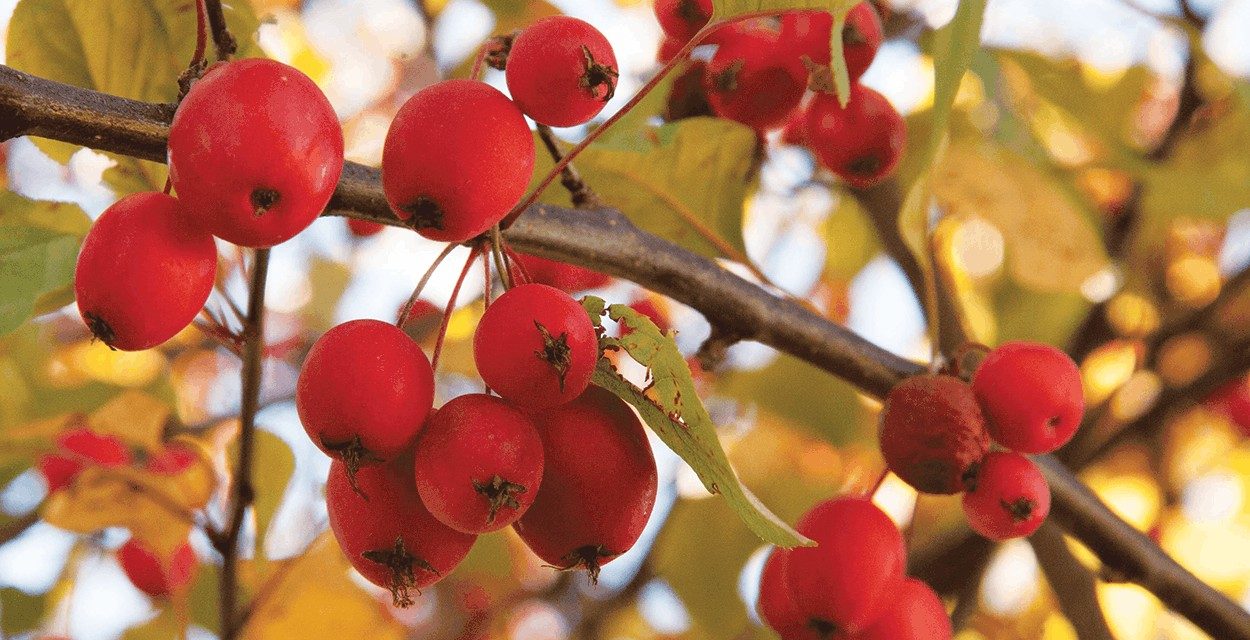By Ellen Zachos

I grew up thinking crabapples were poisonous. (I also grew up thinking life was fair and goodness would be rewarded, so go figure). After all, I never saw anybody eat crabapples, and why would people let all that pretty fruit go to waste if it was worth eating? As an adult, I’ve learned a thing or two about both food and life, and fortunately, crabapples turn out not only to be edible, but versatile and delicious.
Crabapple trees flourish in New Mexico. They make great street trees, excellent garden plants, and you’ll often find them in the wild, where birds have obligingly deposited crabapple seeds. Like regular apples, crabs are in the genus Malus. The primary difference between crabapples and regular apples is that crabapples are small; any apple with a diameter of less than two inches is considered a crab.
The juice of underripe crabapples can be used in place of lemon juice. Traditionally this is called verjus (French for green, as in unripe juice). Underripe crabapples also contain loads of pectin, so if you’re a jelly maker who would rather not use store-bought pectin, crabapples may turn out to be your very best friend.
The flavor of different crabapples varies widely, just as it does among larger apples. Some crabs are extremely sour, and some have a grainy texture. Most crabapples contain lots of tannins, which give them a slightly bitter and astringent flavor. If this sounds like a bad thing, remember that tannins add complexity to teas, coffees, whiskeys, and wines. And if you happen to be a cider maker, adding a few tart crabapples to sweet apples makes for a more interesting beverage.
Fully ripe crabapples will never be sweet, but they will be sweeter than unripe fruit, so let them stay on the tree until fully colored, but harvest before they start to shrivel. Large crabapples (with a diameter greater than one inch) usually have better texture than smaller fruit, and can be eaten raw or pickled. Even small crabapples with a less than alluring texture still have plenty of culinary value. Make a syrup to use as a base for sorbet and ice cream, or combine that syrup with your favorite bourbon to make a classic fall cocktail like the Kentucky Belle. The combination of tart fruit and sweet whiskey is terrific.
Cooking obliterates any textural issues you might have with small crabapples, so use them in cakes, applesauce, and fruit leather. You’ll need to adjust the sweetener if you’re using a traditional apple recipe, since crabapples are almost always more sour than larger apples.
Next time you pass a crabapple tree with ripe fruit, taste one. Yes, it will be sour, but imagine that tartness tempered with a little sugar, a few spices, and maybe a little booze. Then you’ll understand why my kitchen is full of crabapple juice, crabapple sauce, crabapple chutney, and crabapple syrup. Cheers!
Edible celebrates New Mexico's food culture, season by season. We believe that knowing where our food comes from is a powerful thing. With our high-quality, aesthetically pleasing and informative publication, we inspire readers to support and celebrate the growers, producers, chefs, beverage and food artisans, and other food professionals in our community.

















